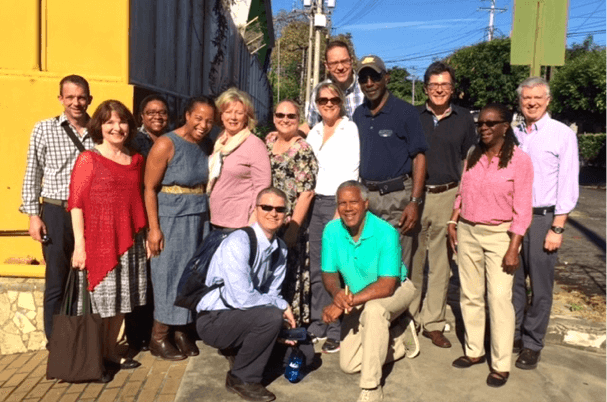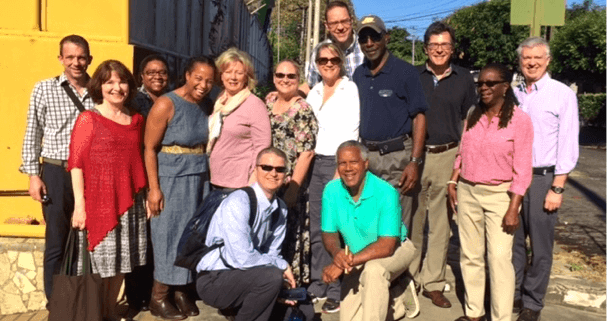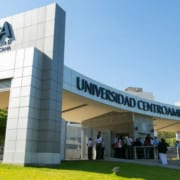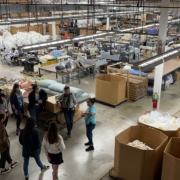Nicaragua: The Irony of Electric Trees
BY DR. TERRY MILLS | April 19, 2016
Dr. Terry Mills is the Assistant Provost for Diversity and Inclusion at John Carroll University in University Heights, Ohio.
As a member of the Ignatian Colleagues Program (ICP), I recently traveled to Nicaragua for a week-long immersion into the culture and history of the country and to engage with the people in the capital, Managua, and its surrounding areas, as well as mountain villages beyond the city of Estelí.

ICP group photo in Nicaragua. Terry Mills is fourth from the right in his John Carroll University cap.
Arriving at the Managua airport at night, I joined a few of my ICP friends while we gathered our luggage and boarded the bus into the capital. As we approached the city, the incredible beauty of the lighted “Trees of Life” (Los Arboles de la Vida) along the main boulevard created an astounding rainbow of colors that guided us to our hotel destination. These metallic trees can be seen on virtually every street in the capital. We all took photos and commented on how welcoming the trees were. As our immersion experience unfolded, however, we would learn how these “trees” have a political underpinning, and for many represent manipulation of symbols that serve to reinforce the presence and power of Rosario Murillo, wife of president Daniel Ortega.
Although Nicaragua is the one of the poorest countries in the Western hemisphere, second only to Haiti, the cost to install the more than 130 “trees” is estimated at $3.3 million, and requires more than $1 million per year for electricity and maintenance. The irony is that in the natural rain forest of Nicaragua, deforestation is occurring, yet the city is being adorned with these electric trees. During the immersion, we learned that a variety of forces are driving deforestation and rapidly increasing pollution. The transfiguration of forests into commercial agriculture and cattle pastures and substantial logging activity with virtually no government regulation are having a severe environmental impact. Consequently, there is significant controversy over land rights, pesticide use, and water access (Foundation for Sustainable Development).
On the first day of our immersion experience, we attended orientation facilitated by Kathy McBride and Mark Lester from the Center for Global Education. They guided us through significant political and historical moments of the country, focusing on Augusto Sandino and the 1927 revolution against U.S. military occupation of the country in an effort to quell unrest over upcoming elections. The Nicaraguan National Guard assassinated Sandino in 1934, and for more than 40 years the dictator Somoza and his family controlled the Nicaraguan government.
The politics of Nicaragua are quite complex and sometimes confusing in terms of distinguishing the good guys from the bad guys. For example, in the 1980s, the Sandinista (FSLN) party, who took their name from the early revolution leader Sandino, implemented a national literacy campaign and other reforms that helped the rural population and especially women. The campaign reduced national illiteracy from 50% to 13%. However, over time, the Sandinistas began suppressing political freedoms and in many ways began to resemble the dictatorial government of Somoza. During this period the counter-revolutionary force known as the Contras emerged supported by the U.S. government. One of the major efforts of the Contras was to disrupt social reforms and economic progress of the country. Part of their effort included planting underwater mines in the harbor, which disrupted shipping. Interestingly, there are many in the country who still support the Contras and Somoza.
However, the immersion experience was not simply a history lesson. Engaging with the culture and people was the principal reason for our trip. During the visit we met with officials of the Incubation Program of NITLAPAN, the Jesuit University of Central America (UCA) think tank, and visited two brilliant craft makers in their villages. Also, we spent a day in a mountain village and had a home-cooked meal that was prepared by the women of the Cooperative Nuevo Amanecer. Several women told riveting stories of their oppression and renewal of spirit. In a meeting with Maria “Pinita” Gurdian, a member of the Christians in the Revolution, we discussed the intersection of faith and politics. On another excursion, we attended a worship service in Batahola at the community center that maintains several beautiful murals representing the new society created by the revolution. Returning to UCA, we gathered with students to hear about their service learning experiences, followed by a visit to the Placencia Tobacco Factory, part of the free-trade zone where mostly women are involved in the production of high-quality cigars for which they earn a higher than average wage.
Integral to the immersion trip were opportunities for group reflection and contemplation on our experiences. Bonding with my colleagues and strengthening our relationships was exhilarating. Yet, I returned to the U.S. with many questions and unresolved emotions having seen first-hand the effects of foreign policy, questionable political structures in Nicaragua, and the juxtaposition of excessive wealth alongside abject poverty. I still struggle with how my experiences and memories of Nicaragua can be kept alive. I often ask myself, “What lessons from my immersion experience can I apply to social injustice in the United States?” In many ways, this question still haunts me.
Terry L. Mills, PhD is associate provost for diversity and inclusion, and professor of sociology at John Carroll University.










Leave a Reply
Want to join the discussion?Feel free to contribute!